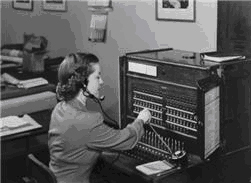Source: VoIP-News.com (News - Alert)
From the early telephone switchboard operator to the digital Internet PBX (News - Alert), telephone systems continue to become more technologically advanced with new features being added each year. Personal communications assistant, unified communications and Web- based call controls are a few of these advancements. In the online publication, Hacking PBX: 20 Tips and Tricks to Optimize your Business Phone System the VoIP News (News - Alert) Staff discusses the idea of a telephone switchboard and how it has progressed over the years.
Daily hundreds of incoming company calls are automatically routed to the appropriate individual and at the same time those individuals are making calls, sending and receiving voicemails, e-mails and faxes with their phones and over the Internet using their PC. By converging voice, messaging and data, individuals and companies are able to improve overall efficiency and reduce overall cost. This allows companies to become more and more competitive.
In the past, a company's incoming calls were manually connected by an operator using switchboards and cords.
In the 1960s, private automatic branch exchange (PABX) was introduced. The PABX allowed employees to make calls to one another within the building or connect to an outside line without having to go through a receptionist. The PABX also allowed companies to reduce their costs by eliminating the need for a large amount of phone lines because of the way internal calls were handled plus this also freed up lines for outgoing calls.

PBX systems (as PABX later became known) had difficulty being accepted despite the cost and time savings they provided. Many companies were not willing to give up their own paid-for systems to spend thousands on new and difficult to use PBX systems.
The last 30 years or so have transitioned switchboards into the electronic age, and through Private Branch Exchange (PBX) technology, many businesses no longer depend on telephone companies to complete many of their internal calls. Today, many companies use internal telephone switchboards, known as IP PBX systems, a development on Private Branch eXchange (PBX) which now incorporates both IP technology and voice over Internet protocol (VoIP) networks.
By the 1980's, manual switchboards had largely been done away with, and were replaced by automated switchboards which worked in the same fashion, but did not require an operator to manually route the call.
In the 1990s, PBX manufacturers started adding flexibility to their systems which allowed expanding them simply by adding ports and card instead of starting over with a new system.
Automated attendants also became easier to use and more accepted in the 1990s. PBX systems started to be integrated with computer technology, making call handling and administration easier. However, this did not put the telephone assistant (operator) out of business because many companies and callers preferred a live person answering the call. The PBX was becoming a high efficient tool to help companies manage their changing needs whether a small business or large call center.
Today, PBX technology is taking on a whole new realm- the Internet world. Instead of routing calls through old circuits, modern PBX solutions use the Internet protocol to exchange information.
The integration of the IP interface has greatly enhanced and expanded the functionality of PBX systems. Now, instead of being restricted to the office, users can work from virtually every corner of the globe, and still experience the full variety of their network's PBX features.
 Internet Telephony Magazine
Click here to read latest issue
Internet Telephony Magazine
Click here to read latest issue CUSTOMER
CUSTOMER  Cloud Computing Magazine
Click here to read latest issue
Cloud Computing Magazine
Click here to read latest issue IoT EVOLUTION MAGAZINE
IoT EVOLUTION MAGAZINE




